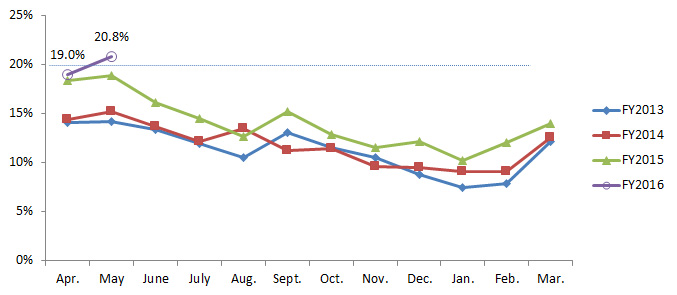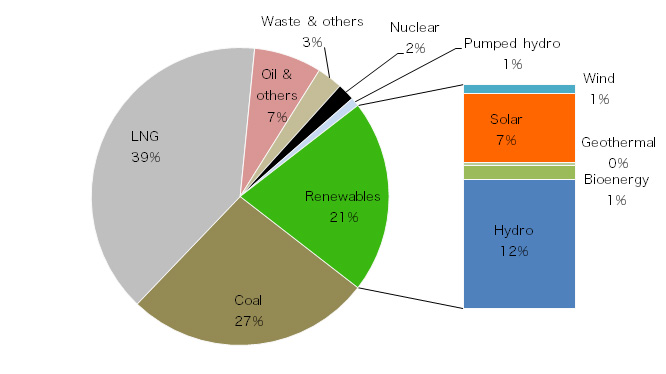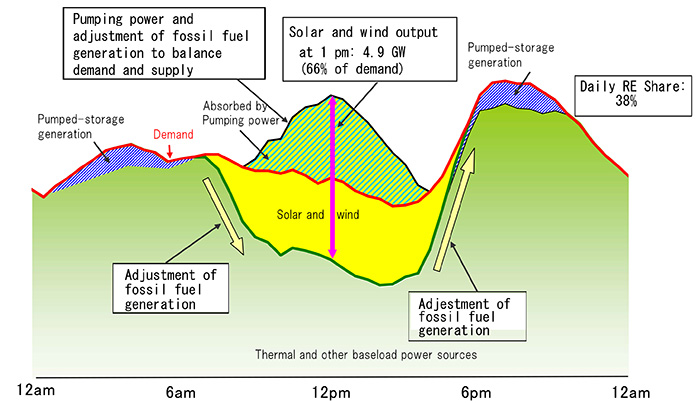Over 20% Renewable Energy Share Achieved on a Monthly Basis in May 2016 in Japanese
In Japan, the proportion of electricity generated from renewable energy had long been around 10%, mostly hydropower. However, under the Feed-in Tariff system, renewable energy has been steadily increasing. In FY2015, the proportion of renewable energy generated and purchased reached 14%, excluding waste-to-energy and pumped-storage hydropower.
Furthermore, on a monthly basis, the proportion of renewable energy finally exceeded 20%, reaching approximately 21% in May 2016 (refer to Figure 1). In other words, although the results are of a single month, we are steadily approaching the 22-24% renewables share target for 2030 set by the Japanese government’s Long-term Energy Supply and Demand Outlook (2015).
In the course of the year, May is the month in which electricity demand is low, while generation by hydropower and solar PV is high. On the other hand, chiefly in the winter months, heating demand increases; whereas the share of renewable energy tends to decrease as hydropower generation drops significantly and generation by solar PV also decreases owing to less solar radiation. In order to increase the share of renewable energy in the winter months, it is important to expand wind power, which has higher performance in the winter.

Figure 1: Proportion of Renewable Energy to Generated and Purchased Electric Power
Note: Renewable energy includes conventional hydropower, solar PV, bioenergy, wind power and geothermal, but does not include waste-to-energy and pumped-storage hydropower.
Source: Created by Renewable Energy Institute based on the Electric Power Survey Statistics prepared by the Agency for Natural Resources and Energy in the Ministry of Economy, Trade and Industry.
A breakdown of the sources of the over 20% share of renewable energy achieved in May 2016 shows that hydropower accounted for 11.5%, followed by 6.6% for solar PV (Figure 2). The proportion of solar PV and wind power together reached 7.4%. Although solar PV and wind power are variable renewables, whose performances vary depending on weather conditions, systematic operational problems have not occurred even with this increased share.

Figure 2: Breakdown of Generated and Purchased Electric Power in May 2016
Source: Created by Renewable Energy Institute based on the Electric Power Survey Statistics prepared by the Agency for Natural Resources and Energy in the Ministry of Economy, Trade and Industry.
Furthermore, when considering shorter units of time (i.e. day or hour), there appears to be a time of day in which the share of variable renewable energy becomes extremely high. Analysis of how this rise has been handled and with what systematic operation will serve as important material in increasing the share of renewable energy in the future.
To cite a case, Kyushu Electric Power Co., Inc. announced that generation output of solar PV and wind power within its jurisdiction reached a total of 4.9 GW, accounting for 66% of demand, on May 4, 2016 at 1 p.m. ⅰ . Although it is difficult to make a detailed analysis since specific data has not been provided on other energy sources and their generating conditions, it has been shown that power supply exceeded demand on account of the operational output of the Sendai Nuclear Power Station and the minimum output of thermal power plants, leading to surplus power, which was consumed by pumped-storage hydropower to maintain a balance.

Figure 3: Conceptual Diagram of Supply and Demand Conditions within the Jurisdiction of Kyushu Electric Power Co., Inc. on May 4, 2016
Source: Kyushu Electric Power Co., Inc. (2016). “Status of Renewable Energy Adoption and the Latest Supply and Demand Conditions”
Pumped-storage hydropower can produce only about 70% of the electricity it consumes to pump up water, in effect losing 30% of electric power. In other words, in considering an efficient electricity operation, other methods of generation must be explored before employing pumped-storage hydropower. For example, it is effective to control the output of baseload power sources (excluding minimum output of thermal generation) such as nuclear power, or transmit electricity to Chubu Electric Power Co., Inc. via the Kanmon Interconnecting Line for consumption in Honshu. However, according to the Organization for Cross-regional Coordination of Transmission Operators, Japan (OCCTO), the operational capacity (transmission to Chubu Electric Power Co., Inc.) of the Kanmon Interconnecting Line is set significantly lower in April and May, when solar PV generates power, than in other months during service time ⅱ . For this reason, the use of the Kanmon Interconnecting Line may likely be controlled in early spring when solar PV generates much power.
For further incorporation of renewable energy into the system, it is essential to improve and strengthen operations to enable more effective use of the inter-regional transmission lines.
ⅰ Kyushu Electric Power Co., Inc. (2016). “Status of Renewable Energy Adoption and the Latest Supply and Demand Conditions”
ⅱ Organization for Cross-regional Coordination of Transmission Operators, Japan (2016). “Additional Volume: Calculation Method and Results of Operational Capacity of Respective Interconnecting Lines” The Fourth Review Meeting of Operational Capacity, materials 1-2

